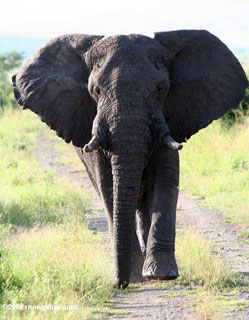Elephants avoid hills
Elephants avoid hills
Safaricom and Vodaphone Foundations
July 24, 2006
Using global-positioning system data corresponding to the movements of elephants across the African savannah, researchers have found that elephants exhibit strong tendencies to avoid significantly sloped terrain, and that such land features likely represent a key influence on elephant movements and land use. On the basis of calculations of energy use associated with traversing sloped terrain by such large animals, the researchers found that this behavior is likely related to the fact that even minor hills represent a considerable energy barrier for elephants because of the added calorie consumption required for such movements. The findings are reported by Fritz Vollrath of the University of Oxford and elephant experts Jake Wall and Iain Douglas-Hamilton of Save the Elephants, and appear in the July 25th issue of Current Biology, published by Cell Press.
Understanding the factors that determine locations of elephant density hot-spots and use corridors is critical in helping to secure safe niches for elephants in the face of growing human encroachment on elephants’ native habitat. In their study of elephant movements, the authors focused on the Samburu/Isiolo/Laikipia districts in northern Kenya, which represent an area of about 32,000 square kilometers of mostly unprotected habitat. This range is home to about 5,400 elephants.
 Adult elephant in Uganda. Photo by R. Butler RELATED: When elephants attack. Surviving an elephant charge in the Congo rainforest of Gabon The elephant charges. The ground trembles. Hearts racing, we are now sprinting through the forest dodging vegetation as the elephant plows right through it. The problem with being chased by an elephant, aside from their obvious size advantage, is they can run faster than you. While wild elephants can be dangerous animals under the right circumstances, other creatures are responsible for more deaths in Africa. Topping the list is the hippo, whose penchant for capsizing canoes that come too close results in the dumping of passengers who often can’t swim. Buffalo, crocodiles, and lions are directly responsible for more deaths and injuries. Mysterious pygmy elephants being tracked across Borneo by WWF The same satellite system used by the U.S. military to track vehicle convoys in Iraq is helping World Wildlife Fund shed light on the little-known world of pygmy elephants in Borneo. This week marks the six-month anniversary of the first pygmy elephant’s being captured and outfitted with a collar that can send GPS locations to WWF daily via satellite. Now, for the first time, the public can track the movements of the elephants online through an interactive web map. Spicy peppers keep elephants out of farmers’ fields What do hot sauce aficionados and African elephants have in common? They both feel the burn of chilli peppers, the key ingredient for resolving human-elephant conflicts in Africa while raising money for farmers and conservation. Supported by the Wildlife Conservation Society (WCS) and other groups, the Elephant Pepper Development Trust (EPDT) has not only promoted the use of chilli peppers as a means of keeping elephants, buffalo, and other species away from important sources of human food, but has also introduced a viable cash crop to the economy of African nations. |
In the course of studying the influences of a range of environmental factors on elephant movement, the authors found that elephant density dropped off significantly with increasing hill slopes. While this effect may well involve such factors as risks of injury and overheating, or lack of water, the authors’ calculations of the energy required for elephants to traverse sloped terrain indicate that the energetic costs of such movement could be a main factor influencing this behavioral tendency. For example, the authors calculate that climbing 100 meters would “burn” energy that would take an extra half hour of foraging to replace–or would need to be paid for by expenditure of body reserves. In light of their calculations, the authors point out in the paper that “clearly, climbing is something that an elephant should not do lightly, but should weigh very carefully.”
On the basis of their findings, the authors suggest that large animals probably take a rather different view of their surroundings than do lightweight animals, and that this is probably especially true of heavyweight animals, like elephants, that are herbivores, for whom energy replenishment can be especially time consuming.
More information about Save the Elephants can be found at: http://www.save-the-elephants.org.
The researchers include Jake Wall of Save the Elephants in Nairobi, Kenya and Queen’s University in Kingston, Canada; Iain Douglas-Hamilton of Save the Elephants in Nairobi, Kenya; Fritz Vollrath of Mpala Research Centre in Nanyuki, Kenya and University of Oxford, South Parks Road in Oxford, UK. The Safaricom and Vodaphone Foundations generously supported this study.
Wall et al.: “Elephants avoid costly mountaineering.” Publishing in Current Biology 16, R527-529, July 25, 2006. www.current-biology.com
This is a modified news release from the Safaricom and Vodaphone Foundations.